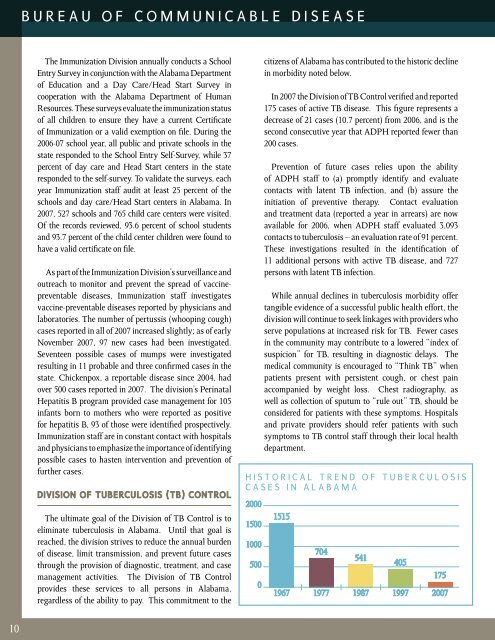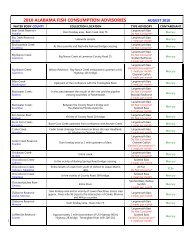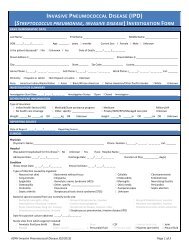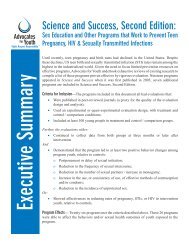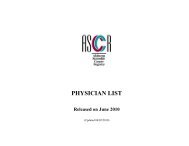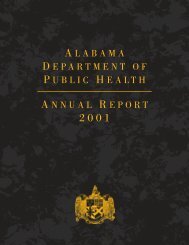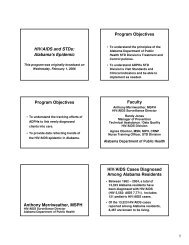2007 - Alabama Department of Public Health
2007 - Alabama Department of Public Health
2007 - Alabama Department of Public Health
Create successful ePaper yourself
Turn your PDF publications into a flip-book with our unique Google optimized e-Paper software.
ureau <strong>of</strong> communicable disease<br />
The Immunization Division annually conducts a School<br />
Entry Survey in conjunction with the <strong>Alabama</strong> <strong>Department</strong><br />
<strong>of</strong> Education and a Day Care/Head Start Survey in<br />
cooperation with the <strong>Alabama</strong> <strong>Department</strong> <strong>of</strong> Human<br />
Resources. These surveys evaluate the immunization status<br />
<strong>of</strong> all children to ensure they have a current Certificate<br />
<strong>of</strong> Immunization or a valid exemption on file. During the<br />
2006-07 school year, all public and private schools in the<br />
state responded to the School Entry Self-Survey, while 37<br />
percent <strong>of</strong> day care and Head Start centers in the state<br />
responded to the self-survey. To validate the surveys, each<br />
year Immunization staff audit at least 25 percent <strong>of</strong> the<br />
schools and day care/Head Start centers in <strong>Alabama</strong>. In<br />
<strong>2007</strong>, 527 schools and 765 child care centers were visited.<br />
Of the records reviewed, 93.6 percent <strong>of</strong> school students<br />
and 93.7 percent <strong>of</strong> the child center children were found to<br />
have a valid certificate on file.<br />
As part <strong>of</strong> the Immunization Division’s surveillance and<br />
outreach to monitor and prevent the spread <strong>of</strong> vaccinepreventable<br />
diseases, Immunization staff investigates<br />
vaccine-preventable diseases reported by physicians and<br />
laboratories. The number <strong>of</strong> pertussis (whooping cough)<br />
cases reported in all <strong>of</strong> <strong>2007</strong> increased slightly; as <strong>of</strong> early<br />
November <strong>2007</strong>, 97 new cases had been investigated.<br />
Seventeen possible cases <strong>of</strong> mumps were investigated<br />
resulting in 11 probable and three confirmed cases in the<br />
state. Chickenpox, a reportable disease since 2004, had<br />
over 500 cases reported in <strong>2007</strong>. The division’s Perinatal<br />
Hepatitis B program provided case management for 105<br />
infants born to mothers who were reported as positive<br />
for hepatitis B, 93 <strong>of</strong> those were identified prospectively.<br />
Immunization staff are in constant contact with hospitals<br />
and physicians to emphasize the importance <strong>of</strong> identifying<br />
possible cases to hasten intervention and prevention <strong>of</strong><br />
further cases.<br />
division <strong>of</strong> TUBERCULOSIS (TB) CONTROL<br />
The ultimate goal <strong>of</strong> the Division <strong>of</strong> TB Control is to<br />
eliminate tuberculosis in <strong>Alabama</strong>. Until that goal is<br />
reached, the division strives to reduce the annual burden<br />
<strong>of</strong> disease, limit transmission, and prevent future cases<br />
through the provision <strong>of</strong> diagnostic, treatment, and case<br />
management activities. The Division <strong>of</strong> TB Control<br />
provides these services to all persons in <strong>Alabama</strong>,<br />
regardless <strong>of</strong> the ability to pay. This commitment to the<br />
citizens <strong>of</strong> <strong>Alabama</strong> has contributed to the historic decline<br />
in morbidity noted below.<br />
In <strong>2007</strong> the Division <strong>of</strong> TB Control verified and reported<br />
175 cases <strong>of</strong> active TB disease. This figure represents a<br />
decrease <strong>of</strong> 21 cases (10.7 percent) from 2006, and is the<br />
second consecutive year that ADPH reported fewer than<br />
200 cases.<br />
Prevention <strong>of</strong> future cases relies upon the ability<br />
<strong>of</strong> ADPH staff to (a) promptly identify and evaluate<br />
contacts with latent TB infection, and (b) assure the<br />
initiation <strong>of</strong> preventive therapy. Contact evaluation<br />
and treatment data (reported a year in arrears) are now<br />
available for 2006, when ADPH staff evaluated 3,093<br />
contacts to tuberculosis – an evaluation rate <strong>of</strong> 91 percent.<br />
These investigations resulted in the identification <strong>of</strong><br />
11 additional persons with active TB disease, and 727<br />
persons with latent TB infection.<br />
While annual declines in tuberculosis morbidity <strong>of</strong>fer<br />
tangible evidence <strong>of</strong> a successful public health effort, the<br />
division will continue to seek linkages with providers who<br />
serve populations at increased risk for TB. Fewer cases<br />
in the community may contribute to a lowered “index <strong>of</strong><br />
suspicion” for TB, resulting in diagnostic delays. The<br />
medical community is encouraged to “Think TB” when<br />
patients present with persistent cough, or chest pain<br />
accompanied by weight loss. Chest radiography, as<br />
well as collection <strong>of</strong> sputum to “rule out” TB, should be<br />
considered for patients with these symptoms. Hospitals<br />
and private providers should refer patients with such<br />
symptoms to TB control staff through their local health<br />
department.<br />
historical trend <strong>of</strong> tuberculosis<br />
cases in alabama<br />
2000<br />
1500<br />
1000<br />
500<br />
0<br />
1515<br />
704<br />
541<br />
405<br />
175<br />
1967 1977 1987 1997 <strong>2007</strong><br />
10


